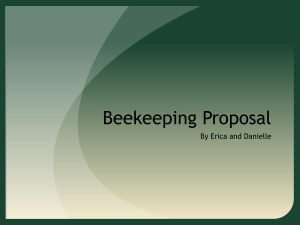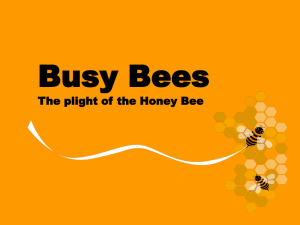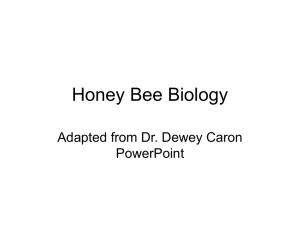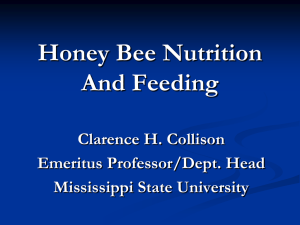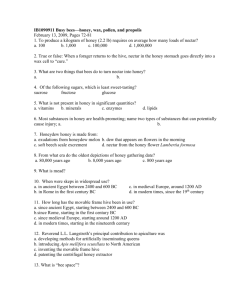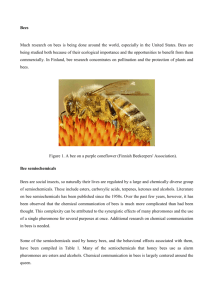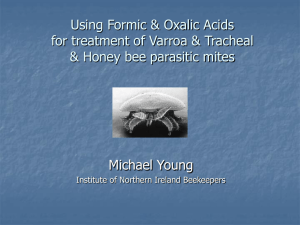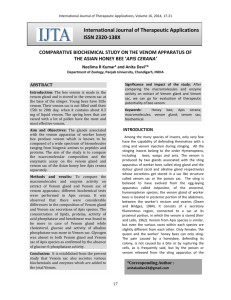Lecture 6 - Products of the Hive
advertisement
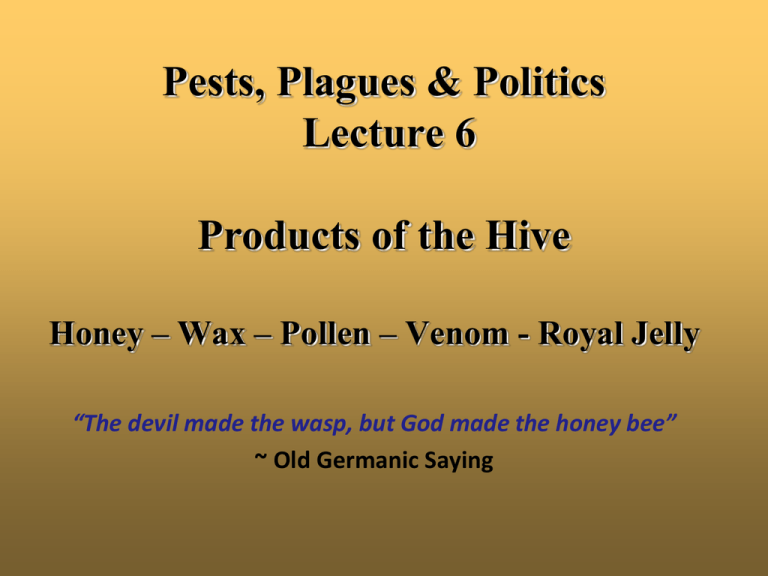
Pests, Plagues & Politics
Lecture 6
Products of the Hive
Honey – Wax – Pollen – Venom - Royal Jelly
“The devil made the wasp, but God made the honey bee”
~ Old Germanic Saying
Key Points
Products of the Hive
• History of Beekeeping
• Modern Apiculture
– Removeable Top Bar Frames
– Bee Space
• Honeybee products
–
–
–
–
Honey
Wax
Pollen, venom, royal jelly
Pollination Services
Prehistoric relations
• Prehistoric records show a honey bee/human
connection going back 6,000 BP
• Humans were essentially another
predator of the honey bee
Smoking the hive
Motopo Hills, Zimbabwe, ca. 10,000 yrs ago
Mesolithic cave painting
Cueva de la Arana, Bicorp, Spain
Historic Record
• Humans eventually began providing
cavities for honey bees to nest in.
• Earliest records are Egyptian
Egyptian beekeeping
Harvesting honey combs (right) and packing honey (left)
ca. 1450 BC, West Bank, Luxor
Apiculture
• The “management” of honey bees
• Primary species utilized:
– Apis mellifera L. – The European honey bee
– Two Biotypes:
• European – adapted for temperate climates
• African – adapted for tropical climates
– Ca. 27 subspecies/biotypes in the world.
• Honey bees to the western hemisphere ca. 1622
by European colonists
WHY KEEP BEES
• Provide valuable products for our comfort,
pleasure, & nutrition.
• These are:
– Honey - 200 million pounds per annum (U.S.)
– Pollination - 16 billion $$ of agricultural
product
– Wax, Pollen, Royal Jelly, Venom
Prior to 1853 Beekeeping was
Inefficient/Wasteful
•Skep hive – used for 2000 years
• made of mud, clay or straw
• unable to inspect for pests, disease
• harvest destructive
The “Modern” Era of Beekeeping
• Started in 1853 with the publication of the
book THE HIVE & THE HONEYBEE
• Written by L.L. Langstroth
– The “Father” of modern beekeeping
• Introduced the concept of “bee space”
• From which the TOP-OPENING, MOVABLE
FRAME HIVE evolved.
Bee Space – when bees
have less than 1 cm to
move around in, they will
not build wax or propolis
attachments to the wall
of a hive, allowing for the
removal of frames
Bee Space
1/4th to 3/8th inch
The modern beehive
HONEY
• A saturated solution of carbohydrates
– ca. 17% water
– ca. 82.5% sugar:
• fructose 38%
• glucose 31%
• maltose 7%
• sucrose
1.5%
• et alia
6%
– ca. 0.5% protein, minerals, vitamins &
• MAGIC
Honey
• Produced from plant nectar
– Primarily from flowers
– Also extra-floral nectaries
• Precursor of nectar is:
– Phloem sap
– Most often a dilute solution of sucrose
• Essentially bees do two things:
– Dehydrate
– Enzymatic “inversion” of sucrose to glucose &
fructose
FYI
+
HONEY
• The first sweetener (long before sugar cane)
• Our first alcoholic beverage (mead)
• Production:
– U.S. 200 million pounds per annum
– World: two billion pounds per annum
• Consumption:
• U.S., one pound - Germany, four pounds
• Myriad of minor uses
– pharmacy - medicinal vehicle & taste
corrective, wound dressing
– cosmetics
BEESWAX
• COSMETICS
– creams, lotions, lipstick
• CANDLES
– liturgical, Jewish, Greek Orthodox, but most of
all the RCC.
• BEEKEEPING
– foundation beeswax
http://en.wikipedia.org/wiki/Ceremonial_use_of_lights#Candles
Comb from Beeswax
Beeswax
• Produced from four pairs of sub-dermal
glands on the underside of the abdomen
of a worker bee.
• When the bee is 10 to 18 days old
• Produced as small, translucent flakes
• Precursor is honey & nectar
(carbohydrates)
Wax scales from
wax glands
BEESWAX COMPOSITION
• Over 300 identified individual components
–
–
–
–
–
hydrocarbons (14%)
monoesters (35%)
diesters (14%)
hydroxy polyesters (8%)
free acids (12%)
Royal Jelly
• Definition
– the glandular secretions of young
worker bees (4-10 days old), produced
by the hypopharyngeal in the head,
used as food for larval bees.
• Composition
–
–
–
–
66% water
14% protein
14% carbohydrate
5% lipid (fats & sterols)
Queen cell
Royal jelly in cell
Bee Venom
• Uses
– As Pure Bee Venom for use in
desensitization
– As quackery for charlatans in
treating a variety of neurological
disorders.
VENOM
• Composition
– a mixture of proteins & peptides
• melittin
50% dry wt
• phospholipase A
12% dry wt
• hyaluronidase
<3% dry wt.
• acid phosphatase
<1% dry wt.
• histamine
<1% dry wt.
VENOM
• Melittin
– lysis of blood & mast cells - release of histamine &
serotonin from mast cells - depression of blood pressure
& respiration.
• Phospholipase A
– cell lysis - pain - toxicity; synergistic with melittin
• Hyaluronidase
– hydrolyzes connective tissue - the spreading factor
• Histamine
– itching & pain
• Acid phosphatase
– involved in allergic reaction
POLLEN
• Plant male gametophyte
– a reproductive structure that carries sperm
• A primary food substance for bees
– directly as food to older larvae
– indirectly as the precursor for royal jelly
{think of honey bees as specialized herbivores}
POLLEN COMPOSITION
• Protein
– from 6 to 28%
• Lipids
– from 1 to 20%, but usually <5%
Pollen grain of chamomile flower
• Sterols
– <less than 0.5%
• Additionally
– sugars, starches, vitamins, minerals
Why eating pollen might not be
such a good idea!!
• Economics
$8 to $12 per pound
• Nutrition
= that of soybean flour
Not quantifiable
• Pesticide residues
Especially fungicides
• Allergies
Greatest Value of {honey} Bees
• Pollination
– U.S. = 15 billion $/annum
– Oregon = 600 million $/annum
• Fiscal mainstay for commercial beekeepers in PNW.
Key Points
Products of the Hive
• History of Beekeeping
• Modern Apiculture
– Removeable Top Bar Frames
– Bee Space
• Honeybee products
–
–
–
–
Honey
Wax
Pollen, venom, royal jelly
Pollination Services



